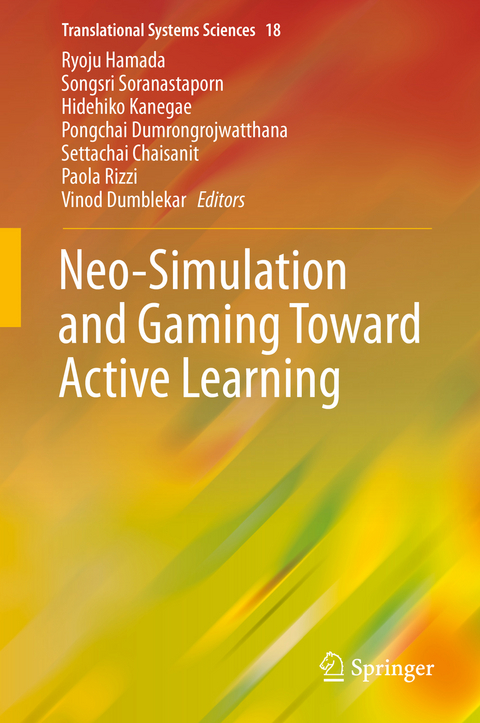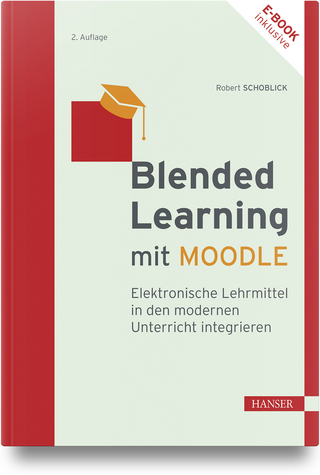
Neo-Simulation and Gaming Toward Active Learning
Springer Verlag, Singapore
978-981-13-8038-9 (ISBN)
Ryoju Hamada, Thammasat University, Sirindhorn International Institute of Technology. Songsri Soranastaporn, Mahidol University, Faculty of Liberal Arts. Hidehiko Kanegae, Ristumeikan University, Graduate School of Policy Science. Pongchai Dumrongrojwatthana, Chulalongkong University, Faculty of Science. Settachai Chaisanit, SPUC, School of Information Technology. Paola Rizzi, University of L’Aquila.
Part 1. Various Applications of S&G.- Chapter 1. Introducing Arrival City Game for Neighborhood Diversity.- Chapter 2. Designing a Human Computation Game for Enhancing Early-Phase Movie Box Office Prediction.- Chapter 3. Hallucifear: Educational Game about Drug Addiction.- Chapter 4. A Perspective on the Needs for Simulation and Gaming Technology in Outpatient Care.- Chapter 5. A Simulation Game of Patient Transportation.- Chapter 6. A Simulation Game for Anticipatory Scheduling of Synchromodal Transport.- Chapter 7. From Discussions to Games - Facilitating Interactions between Experts from Aviation and Humanitarian Aid.- Chapter 8. 3D Periodic Sugoroku Game for Active Learning of the Periodic Table.- Part 2. S&G to Learn Business.- Chapter 9. A Business Simulation Game to Teach How to Comprehend Financial Statements.- Chapter 10. Co-Creating Prototype Improvement using Participatory Design on the Development of a Serious Game in Financial Literacy Skills.- Chapter 11. Bis Augmented Reality in Finance Learning Games.- Chapter 12. Learning Efficacy among Executives and Students of an Organizational Growth Game.- Chapter 13. Business Game Promoting Supply Chain Collaboration Education at Universities.- Chapter 14. How can we ensure Middle School Students Acquire Economic Thinking? Developing and Evaluating an Analog Game Involving Smartphones Simulated with LEGO® blocks.- Chapter 15. Simulation Games to Foster Innovation: Insights from the Transport and Logistics Sector.- Chapter 16. Disrupting Traditional Business Test by Internet Based Simulation Game.- Part 3. S&G to Learn Environmental Issues.- Chapter 17. Methodology for Environmental Learning based on Material Flow Diagram of Green Multi-Dimensional Bookkeeping System.- Chapter 18. Board Game for Collective Learning on Green Roof Ecosystem Services.- Chapter 19. Design of Simulation and Gaming to Promote the Energy Transition from Fossil Fuels to Renewables.- Chapter 20. Agent-based Gaming for Two-sided Electricity Markets.- Chapter 21. Using Role-Play Game for Active Learning to Solve Water Inequity.- Part 4. S&G in Disaster Management.- Chapter 22. Gaming Simulation as a Tool of Problem-based Learning for University Disaster Education.- Chapter 23. A Study on Gaming of Participatory Evacuation Planning in Tourist Areas using Agent Simulation.- Chapter 24. A Study on Effect of “Information Mismatch” Simulation on Victims’ Quality of Life and Sense of Place in the Post-Disaster Period.- Part 5. S&G with the Latest Technology.- Chapter 25. Empirical Studies on the Role of Matchmaking in Mobile eSports Players Engagement.- Chapter 26. Learning via AI Dolls: Creating Self-Active Learning for Children.- Chapter 27. Virtual Reality for Active English Learning in the University Context.- Chapter 28. Research on User Experience in Risk Management Alternate Reality Game.- Part 6. S&G to facilitate Consensus Building.- Chapter 29. Rights-Conversion Type Urban Redevelopment Game Considering Financial Risk Management.- Chapter 30. Impact Finder: Board Game as a Tool for Social Impact Assessment Knowledge Transfer.- Chapter 31. A Study about the Changes of Participants’ Impressions through a Brainstorming Group Work.- Chapter 32. Eliciting Requirements of a Knowledge Management System for Gaming in an Organization: The Role of Tacit Knowledge.- Chapter 33. Community Forest Board Game for Learning Interactions Among Ecosystem Components in Community Forest with Local People.- Chapter 34. For Gaming-based Consensus Building: Problem Formulation of Snowfall Disaster Mitigation in Japanese Rural Area.- Chapter 35. Wadakamari Gaming - Which Promotes Players' Viewpoint Switching in Consensus Building.- Part 7. S&G for Empowerment of Human Mind.- Chapter 36. Experience Design for Understanding Social Withdrawal: Employing a Live-Action Role-Play (LARP) to Learn about and Empathize with Hikikomori in Japan.- Chapter 37. Hooshmand – Intelligence and Emotion Entangled in a Simulation Game.- Chapter 38. Self-Esteem Building Activity: Personality Development of Thonburi University Students.- Chapter 39. City of Emotions – Case Studies for a Broader Scope of Intervention.- Chapter 40. Arising Hope after Disaster: the Parcobaleno Project.- Part 8. NEO-Simulation Gaming toward Active Learning Era.- Chapter 41. Building Theoretical and Practical Experiencing Through an Integrated Active Learning Approach Using Case Studies and a Problem-Based Learning Methodology in International PBL.- Chapter 42. Bis Physical and Mental Environments for Simulation and Gaming: The Facilitator’s Role as a Designer of Environments.- Chapter 43. The Context Dependency of Four Persuasive Game Design Principles.- Chapter 44. Digital Versus Analogue Multi-Player Gaming:Comparing Learning Outcomes.- Chapter 45. Simulation Game Complexity Perception: An Approach to The Research Model.- Chapter 46. How to Describe a Large Business on a Business Board Game: An Illustration of Construction Company.- Chapter 47. Virtual Lesson Game for Prompting Teachers to Change Their Instructional Style to Promote the Integration and Utilization of Knowledge in Problem-Solving.- Chapter 48. The Effects of Debriefing on the Performance and Attitude of Austrian University Students and Cultural Differences to Japanese Students.- Chapter 49. What Business Simulations Teach: The Effect of Debriefing.- Chapter 50. Gaming Simulation Validation: Matching Participants’ Worldviews with Their Decisions.- Chapter 51. Educational Gamification: Challenges to Overcome - and to Enjoy.
| Erscheinungsdatum | 28.10.2019 |
|---|---|
| Reihe/Serie | Translational Systems Sciences ; 18 |
| Zusatzinfo | 90 Illustrations, color; 67 Illustrations, black and white; XX, 560 p. 157 illus., 90 illus. in color. |
| Verlagsort | Singapore |
| Sprache | englisch |
| Maße | 155 x 235 mm |
| Themenwelt | Schulbuch / Wörterbuch ► Unterrichtsvorbereitung ► Unterrichts-Handreichungen |
| Mathematik / Informatik ► Informatik ► Theorie / Studium | |
| Sozialwissenschaften ► Pädagogik ► Sozialpädagogik | |
| Sozialwissenschaften ► Soziologie ► Spezielle Soziologien | |
| Wirtschaft ► Allgemeines / Lexika | |
| Wirtschaft ► Volkswirtschaftslehre ► Wirtschaftspolitik | |
| Schlagworte | Active learning • Cross-disciplinary • Policy Exercise • Simulation and gaming • Social Science • Translational System Science |
| ISBN-10 | 981-13-8038-4 / 9811380384 |
| ISBN-13 | 978-981-13-8038-9 / 9789811380389 |
| Zustand | Neuware |
| Haben Sie eine Frage zum Produkt? |
aus dem Bereich


